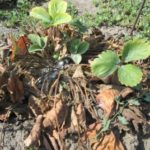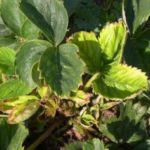The fact that gardeners groom and nurture in their garden plots, calling them strawberries, is in fact a large-fruited garden strawberry, often called Victoria. Today, it is grown as a cultivated plant, as a result, many species and varieties of this berry have been bred, one of which we will get to know.
More than half a century strawberry varieties Masha remains one of the most popular on the backyards of our country. It has several advantages that allow it to compete with foreign hybrid varieties. A detailed description of this variety can be found below.
Table of contents
Description of the strawberry variety Masha
History of creation
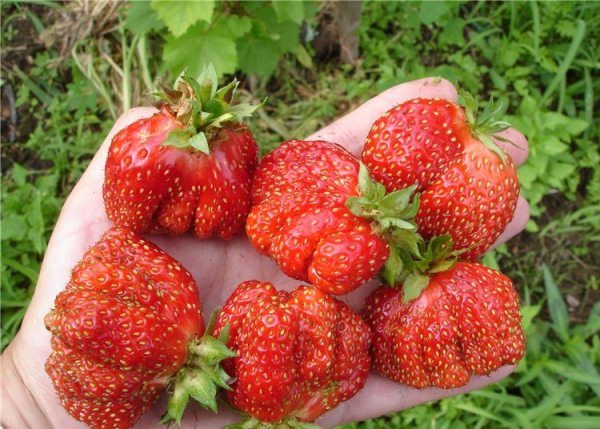
Variety bred by domestic breeders at the State Farm. V.I. Lenin, Moscow region in 1953. This strawberry is also called Moscow Jubilee. Created by breeder N.K. Smolyaninovoy. It was derived from varieties Komsomolka and Beauty Zagorya. It is believed that the name of the variety was given in honor of the daughter of the director of the state farm, whose name was Masha. This variety is rightfully one of the most popular thanks to its large fruits, high yield and good taste.
Positive and negative aspects of growing a variety
Masha attributed to the mid-early varieties, the crop is harvested in early June.Fruits of bright color, slightly flattened, resemble a scallop.
The advantages of this class include:
- large fruitsreaching 100-130 grams;
- the pulp of the berries is densethat facilitates the storage and transportation of this variety;
- resilience to diseases;
- winter hardiness;
- delicious berriesnot hollow;
- high taste qualities.
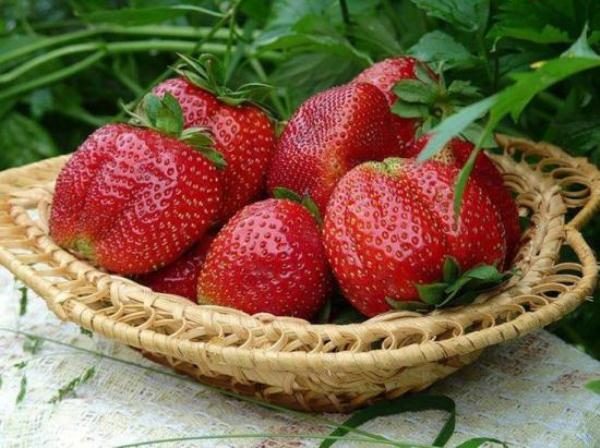
There are also disadvantages:
- does not like direct sunlightd, because of them, spots appear on the leaves;
- due to the large size of the berries average yield, suitable for home gardens, but in large enterprises are usually not grown.
Natural growth region and cultivation features in other regions
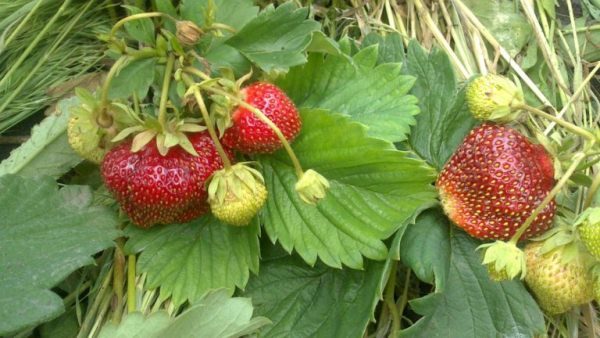
The variety Masha is quite resistant to various temperatures, which is why it is so common throughout the country: in cold and warm regions.In warm climates, you can achieve re-fruiting. To do this, use a method such as cutting shoots.
In colder conditions, only one crop per year can be harvested.
Planting strawberries
Preparation of beds
Mashenka is one of the most unpretentious varieties, however, a number of features should be taken into account.

It grows best on the southwestern and western slopes. In low places, strawberries will be too damp, and on the southern slope it will snow early, and plantings will be poorly protected from the cold.
The most favorable time for landing is the end of May or July-August.. When planting in the spring, the crop is harvested in the same year.
If you plant strawberries at the end of the summer, then the harvest should be expected next year.
Before planting it is necessary to prepare the soil.. To begin with, the soil is treated with insects. For this there are a large number of special means - insecticides. Next, make humus and sand and dig. Strawberry loves light, "breathing" soil. Sand is made at the rate of 5 kilograms per square meter, and humus in the amount of about 15 kilograms per square meter. Then it is necessary to loosen the top layer of soil.
Fertilization, layout and timing
To obtain a high yield, it is important not to forget about the timely application of fertilizers. It is especially important to provide the plant with nutrients during the period of active growth.
There are various fertilizer recipes:
- Add to compost bucket 20 grams of potassium chloride, 35–45 grams of superphosphate, then add 20–25 g of urea.
- Mix in one container in equal proportions of earth, manure, pergnoy (one bucket each), add 2 cups of ash.
- Add to the ash glass 30 gr superphosphate and 30 gr humus.
In early spring, organic is used as a fertilizer. (manure, humus, compost), also use nitrogen fertilizers. Nitrogen promotes active growth after the winter period.

In April, recommended complex fertilizers or compounds with a high content of phosphorus and potassium. Potassium increases resistance to diseases, and phosphorus has a beneficial effect on the root system.
Before flowering the plant requires nutrients derived from organic matter.
Landing
The strawberry variety Masha grows well in a warm place, slightly protected from the direct rays of the sun. Landing is made in late March or late July - August.
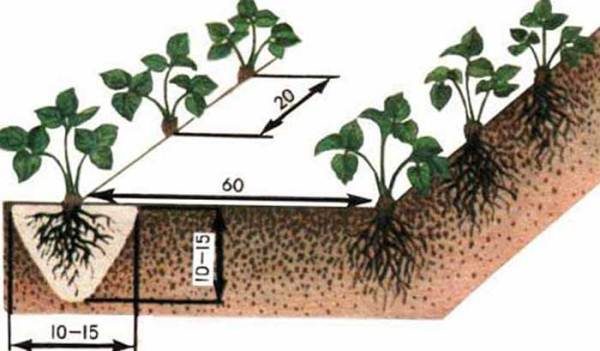
Planted plants should be at a distance 40-50 cm apart. The distance between the rows also maintain about 40 cm. You should not plant the seedlings tightly, remember that adult strawberries need space, because it produces a sufficient number of whiskers, a lot of peduncles, which then turn into large fruits.
If you buy ready-made strawberry seedlings, then you do not need to buy young plants in doubtful places, choose a reliable seller. Give preference to completely healthy plants without a trace of disease or pest damage.

For landing, choose a not too sunny day. In the soil make a small depression - the hole. We pour water over the hole and add fertilizer. Place the plant so as not to deepen the leaves too much, otherwise the strawberry may rot. Then gently sprinkle the roots with earth. After planting, water the seedlings, slightly compact the soil.
Post-treatment care
After planting, care is not complicated, because the Masha grade is marked as unpretentious. If you notice bare roots, then sprinkle them with earth. When spring planting, cover young saplings from frost.. It should pritenit strawberries from the scorching sun. Do not overdo it with fertilizers, otherwise they will not do good, but to the detriment. According to many gardeners, if fertilizers were applied during planting in sufficient quantities, then in the first year, additional feedings will no longer be required. When the fruiting period comes, the plants do not feed.
Ensure sufficient watering, best in the morning.. Do not forget to deal with weeds in time. Carefully loosen the soil: the roots of strawberries are located close to the ground, they are easy to damage.
Mulch strawberries with hay or pine needles. This procedure will help protect the berries from rot, because the fruit does not touch the ground.
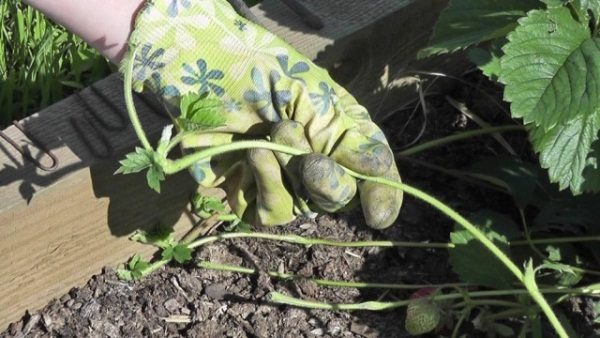
When the berries begin to appear, you need be sure to remove the mustache from strawberriesotherwise they will take away too many nutrients, and the harvest will be much worse.
Collect ripe berries in a timely manner., do not let them rot on the bush.In a rainy, damp summer, you can provide beds of covering material.
When collecting the berries are plucked along with the stem to prevent product deterioration during transport and storage. Overripe berries are not subject to transportation. Strawberries are immediately collected in small containers, so as not to crush again. Damaged fruits must be removed from healthy and whole. As a rule, for transportation use capacity no more than two kilograms.
Strawberry reproduction
There are three ways to grow strawberries.:
- The division of the bush.
- Usa.
- Seeds.
Division bush
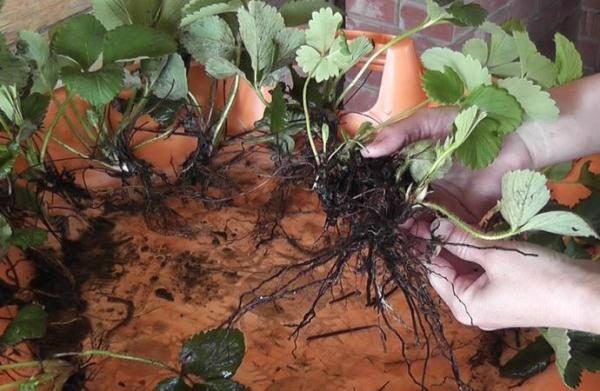
It is used for adult plants aged 3-4 years. This method is effective for remontant strawberries.which almost does not form a mustache. The bush is dug in spring or autumn, divided into several parts (horns). Each of them is then planted in the ground.
Usa
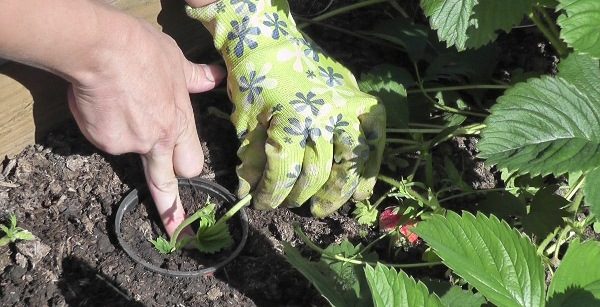
Usta strawberries are propagated most often. This method is suitable for breeding varieties Mashabecause this strawberry has quite a lot of whiskers. It is necessary to choose the first mustache of the strongest and most productive plants and put them on the ground between the rows.Superfluous mustache necessarily break off. Very soon, leaves and roots will appear on the whiskers. Do not rush to separate a small bush from a large one. Cut the ends of the whiskers so that they are left on one rosette of leaves. Separate the young plant from the mother plant 7 days before transplantation, and after a week, feel free to transfer to a new place.
Seeds
Seed strawberry multiply more difficult. In early March, prepare the tanks, pour in a mixture of earth, peat and sand. You can add vermiculite to the looseness of the soil. Seeds are sown in damp ground, then covered with film.. They usually germinate in a week and a half. When the three leaves grow, the seedlings should be dived and deposited in separate cups. Seedlings can be planted in the ground, when she will have 5-7 of these leaves.
Features fruiting varieties
Variety Mashenka or Moscow Jubilee famous for large fruits that reach 130 grams in the first harvest. In subsequent yields of berries are less: 30-50, at least 70 grams. As a rule, gardeners speak well of this variety, note its unpretentiousness and high yield, resistance to diseases.
Diseases and pests
Variety Mashenka little susceptible to disease, especially to rot. but There are a number of problems that gardeners face in growing this variety:
- Mealy dew - leaves and fruits are deformed, covered with white scurf, like flour. To combat the drug used Topaz or soda ash. For prevention, it is recommended to destroy dry leaves.
- Strawberry Mite - the plant does not develop, the fruits are very small, the leaves are yellowed. To combat the tick, it is necessary to process the plant with colloidal sulfur before flowering. After harvesting, apply the solution of karbofos. For prevention, it is advised to remove the leaves before hibernation, as well as fight weeds.
- Strawberry Nematode - Signs are thickened shoots, deformed leaves, fruits are practically absent. For treatment, it is proposed to withstand seedlings in hot water before planting, and then in cold water.
- Strawberries are affected by powdery mildew.
- Strawberry mite is very harmful to strawberries.
- Strawberry bush struck by a nematode
Preparing for the winter
After the harvest, you need to hold activities that prepare strawberries for wintering.

First cut off all the old leaves.without damaging the young leaves. In the southern regions, the strawberry Masha has time to re-yield.
Then make the necessary fertilizers.. After that, mulch the soil with hay, needles or sawdust. Plants do not cover, as the variety is frost resistant to -30 degrees. It is necessary to take care of covering material only in the case of a harsh, snowless winter.
Conclusion
Grade Masha positively recommended and great for growing in private farms. Follow the simple rules of care, and the strawberries will please a good harvest.


